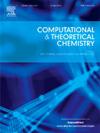Reaction mechanism of palladium-catalyzed intramolecular cyclization/hydroamination of 1-(2-aminophenyl)-3-phenylprop-2yn-1-one, CN bond formation processes studied with DFT calculations
IF 3
3区 化学
Q3 CHEMISTRY, PHYSICAL
引用次数: 0
Abstract
DFT calculations using the B3LYP level of theory were carried out in order to determine the mechanisms of the hydromination reaction and of the cyclization reaction of 1-(2-aminophenyl)-3-phenylprop-2yn-1-one R1. Hydromination of R1 by diethylamine leads to 2-phenylquinolin-4 (1H)-one P1, while the catalytic cyclization using different palladium complexes as catalysts leads to the production of (2Z)-2-benzylidene-1,2-dihydro-3H-indol-3-one P2. Analyzing the potential energy surface indicates that the formation of the C![]() N bond in the presence of diethylamine is related to high activation energies. In addition, the calculations show that there are two reaction paths for the palladium-catalyzed cyclization reaction of R1; the first one is of [1,6]-H shift type while the second is of [1,5]-H shift type, followed by the formation of a C
N bond in the presence of diethylamine is related to high activation energies. In addition, the calculations show that there are two reaction paths for the palladium-catalyzed cyclization reaction of R1; the first one is of [1,6]-H shift type while the second is of [1,5]-H shift type, followed by the formation of a C![]() N bond. In each case, this is the rate-determining step. We compare the Pd complexes and determine the one with the best catalytic performance in the production of P2.
N bond. In each case, this is the rate-determining step. We compare the Pd complexes and determine the one with the best catalytic performance in the production of P2.

用DFT计算研究了钯催化1-(2-氨基苯基)-3-苯基丙烷-2 - n-1- 1- CN键形成过程的分子内环化/氢胺化反应机理
为了确定1-(2-氨基苯基)-3-苯基prop-2 - n-1-one - R1的氢化反应和环化反应机理,采用B3LYP理论水平进行了DFT计算。二乙胺对R1的氢化反应生成2-苯基喹啉-4 (1H)- 1 P1,而不同钯配合物的催化环化反应生成(2Z)-2-苄基-1,2-二氢- 3h -吲哚-3- 1 P2。势能面分析表明,在二乙胺存在下CN键的形成与高活化能有关。此外,计算表明,钯催化R1的环化反应有两条反应路径;第一个是[1,6]-H移位型,第二个是[1,5]-H移位型,然后形成CN键。在每种情况下,这都是决定速率的步骤。我们比较了钯的配合物,确定了在生产P2时催化性能最好的钯配合物。
本文章由计算机程序翻译,如有差异,请以英文原文为准。
求助全文
约1分钟内获得全文
求助全文
来源期刊

Computational and Theoretical Chemistry
CHEMISTRY, PHYSICAL-
CiteScore
4.20
自引率
10.70%
发文量
331
审稿时长
31 days
期刊介绍:
Computational and Theoretical Chemistry publishes high quality, original reports of significance in computational and theoretical chemistry including those that deal with problems of structure, properties, energetics, weak interactions, reaction mechanisms, catalysis, and reaction rates involving atoms, molecules, clusters, surfaces, and bulk matter.
 求助内容:
求助内容: 应助结果提醒方式:
应助结果提醒方式:


